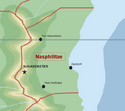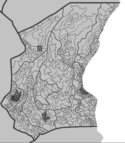Nasphilitae (Pacifica): Difference between revisions
(~~~Fixed infobox (kind of). For some reason, "sovereignty type" and "establishment event(s)" with "establishment dates" break the infobox, so I added them as subheadings in the history section.) Tag: 2017 source edit |
(~~~Added basic introductory information narrated in OOC. Hopefully this aids in understanding the RP on the Forums.) Tag: 2017 source edit |
||
| Line 73: | Line 73: | ||
}} | }} | ||
'''Nasphilitae''' ''⟪nāsfɪlɪtɛ⟫'', officially the '''Grand Duchy of Nasphilitae''' is a county in [[Crabry (Pacifica)|Crabry]]. Its [[Vertical Division of Power in Nasphilitae (Pacifica)|fifteen Thanes]] and [[Nobility of Nasphilitae (Paifica)|seventy-five Earldoms]] (five Earldoms within each Thane), lies on the southern portion ''("Supra-South")'' of the [[South Pacific (Pacifica)|South Pacific Ocean]], stretching inland west until the [[Geography of Nasphilitae (Pacifica)|Western Mountlands]] which borders [[Esfalsa (Pacifica)|Esfalsa]], south until the [[Geography of Nasphilitae (Pacifica)|Southern Mountlands]] which borders [[Jakub (Pacifica)|Jakub]] and north until the non-natural border with [[Phanama (Pacifica)|Phanama]]. Lack of inland rivers, physical barriers to the North and openness to the Oceanic streams contribute to a wide range of both [[Geography of Nasphilitae (Pacifica)|meteorological, geological and biomic]] diversity and volatility. It is a [[Demographics of Nasphilitae (Pacifica)|sparsely inhabited country]] of 17.77 million citizens, with the vast majority residing on the ''"barriers"''. These include: Along the coast, colloquially dubbed the ''"Brownfield Coastline"'' where the most populous [[Cities of Nasphilitae|City in Nasphilitae Agorport]] is; The Aforementioned [[Geography of Nasphilitae (Pacifica)|Southern Mountlands]] where the [[Cities of Nasphilitae|third most populous City in Nasphilitae New Sorthane]] is located; And along a portion of the aforementioned [[Geography of Nasphilitae (Pacifica)|Western Mountlands]], mainly around [[Cities of Nasphilitae|the Capital and second largest City Suhavenster]] is seated. | |||
The above, in aggregate, explain the [[Demographics of Nasphilitae (Pacifica)|deep regional divide]] within the country. | |||
Little is known about indigenous peoples, though [[Culture of Nasphilitae (Pacifica)|they've played a role in shaping the initial settlers culture]], as evident today by [[Religion in Nasphilitae (Pacifica)|customs, rituals and pantheon myths]] practiced by the citizens. | |||
No definitive answer as to why the settle-colonists from the [[Austra (Pacifica)|Austral Empire]] have chosen to arrive and eventually establish Nasphilitae. Two theories with the most consensus elaborate the decision either by suggesting that Nasphilitae was granted by the Imperial Nobility to [[Nobility in Nasphilitae (Pacifica)|Nasphiliti Settling Nobility]] as a reward for some prior delict. The other theory suggests that Nasphilitae was a safe haven for [[Religion in Nasphilitae (Pacifica)|various denominations and religions]], which explain the non-noble settlers. | |||
The Nasphiliti political & justice system has been described as ''"confusing"'' by foreigners. Nasphilitae is a highly localised, [[Wikipedia:Regional state|regional]], [[Wikipedia:Elective monarchy|Electoral monarchy]], with an [[Wikipedia:Uncodified constitution|Uncodified constitution]]. | |||
The country's [[Politics of Nasphilitae (Pacifica)|Head of Government]] is the Head of Government and Speaker, elected every seven years, as the leader of the winning [[Political Parties in Nasphilitae (Pacifica)|political party]] in [[Politics of Nasphilitae|the Lower House National Elections]]. The [[Nobility of Nasphilitae|Head of State]] holds the title of [[Nobility of Nasphilitae|Grand Duke]], nominated among the [[Nobility of Nasphilitae|Fiften Peers]] (uniformly called ''"The Peerage"'') by other Peers and Earls, prior to the winning nominees being subject to [[Politics of Nasphilitae|National elections]], after which they serve for life. The official and mandatory language of Nasphilitae is [[Austral (Pacifica)|Austral]], though most of the citizens speaks at least two additional languages fluently [[Education in Nasphilitae (Pacifica)|due to the education systems emphasis]] on [[Wikipedia:Regional studies|regional cultural studies]]. | |||
Importantly, [[Legal system of Nasphilitae (Pacifica)|the domestic, common law]] does not recognise the concept of ''"ethnicity"'' nor does the National Registry conduct it. A similar, though harsher, regulations exist regarding [[Religion in Nasphilitae (Pacifica)|religious affiliation]]. Namely, it is prohibited from confessing which denomination or religion citizens adhere to in public, justifying it by [[Culture of Nasphilitae (Pacifica)|the commonly held belief]] that religious freedom is best kept if it is kept private. However, the National Registry conducts information classified as ''"Theism"'' or ''"Agnostic Theism"'', with ''Atheism being prohibited'', despite Nasphilitae being a secular country. With 96-98% of the population identifying as ''"Theistic"'', Nasphilitae is one of the most religious countries in the [[South Pacific (Pacifica)|South Pacific]]. | |||
It is, counter-intuitively to previous statements, notable that Nasphilitae is both very [[Culture of Nasphilitae (Pacifica)|assimilatory and multicultural]] at the same time, likely due to [[History of Nasphilitae (Pacifica)|periods of high immigration]] usually during global conflicts, coupled with [[Legal system of Nasphilitae (Pacifica)|historically lax immigration laws]]. One of the reasons for high immigration is that '''Nasphilitae has never participated directly in an external armed conflict''' and has had only '''a single armed conflict inside the country''' during [[History of Nasphilitae|collapse of the Military Junta regime]] in 1958-1963. | |||
<!--- Final Paragraph, Elaborate on basic economic metrics and multilateral participations ............. '''Nasphiliti economy''' is presumed to the property of the following: ''developing'', ''emerging'', or ''“newly (re)industrialised economies”''. This dispute is a produce of there existing clear, '''mere five political economic approaches'''. Characteristics of the economy are: strict division of labour-sector; high inequality; social/public property in addition to state and private; former monopoly on two specific finance services. ---> | |||
==Geography== | ==Geography== | ||
{{See also|Geography of Nasphilitae (Pacifica)}} | {{See also|Geography of Nasphilitae (Pacifica)|Vertical Division of Power in Nasphilitae (Pacifica)}} | ||
===Physical Geography=== | ===Physical Geography=== | ||
| Line 90: | Line 102: | ||
===Pollution Issues=== | ===Pollution Issues=== | ||
===Administrative Divisions and Regionalism=== | |||
==History== | ==History== | ||
| Line 126: | Line 140: | ||
==Demographics== | ==Demographics== | ||
{{See also|Cities of Nasphilitae (Pacifica)|Cultural Exchange Institutes of Nasphilitae (Pacifica)|The National Registry of Nasphilitae (Pacifica)}} | {{See also|Demographics of Nasphilitae (Pacifica)|Cities of Nasphilitae (Pacifica)|Cultural Exchange Institutes of Nasphilitae (Pacifica)|The National Registry of Nasphilitae (Pacifica)}} | ||
==Politics== | ==Politics and Legal System== | ||
{{See also|Politics of Nasphilitae (Pacifica)}} | {{See also|Politics of Nasphilitae (Pacifica)|Political Parties in Nasphilitae (Pacifica)|Legal system of Nasphilitae (Pacifica)}} | ||
===Current System=== | ===Current System=== | ||
| Line 170: | Line 184: | ||
==Education== | ==Education== | ||
{{See also|Schooling System of Nasphilitae (Pacifica)}} | {{See also|Schooling System of Nasphilitae (Pacifica)|Education in Nasphilitae (Pacifica)}} | ||
===Information about Nasphilitae=== | ===Information about Nasphilitae=== | ||
Revision as of 02:26, 26 February 2024
Grand Duchy of Nasphilitae | |
|---|---|
Motto: "Beauty is Joy is Wisdom is Sentiment is Truth" | |
 Physical Map of Nasphilitae | |
 Political Map of Nasphilitae | |
| Location | Southwest of the Crabry continent |
| Capital | Suhavenster |
| Largest city | Agorport |
| Official languages | Austral |
| Recognised regional languages | Alman, Montacian, Friean, Cimbrian, Aegean, Kotomoto, Pelinese Hinomoto, Gara, Karnetvorian, Sedunnic |
| Demonym(s) | Nasphiliti |
| Government | Regional Electoral Monarchy Democracy |
| Dawson Ernst | |
| Syd G. Patton | |
| Nowell Riley Trenton | |
| Claire Renske | |
| Legislature | The National Parliament |
| The Upper House of Localities | |
| The Lower House of Country Collective | |
| Area | |
• Total | 75,704 km2 (29,229 sq mi) |
| Population | |
• 2024. census | 17,775,000 |
• Density | 234.792/km2 (608.1/sq mi) |
| GDP (nominal) | 2022 estimate |
• Total | ∮1.465 trillion |
• Per capita | $10,820 |
| Gini (2024.) | 43.61 medium |
| Currency | Nasphiliti Pacifican Pound Sterling ∮ (NPP) |
| Time zone | UTC0 (Coordiated Universal Time UTC) |
| Date format | mm/dd/yyyy |
| Mains electricity | 120/240 V–50 Hz |
| Driving side | left |
| World Forum Code | NP/NPE |
| Internet TLD | .np |
Nasphilitae ⟪nāsfɪlɪtɛ⟫, officially the Grand Duchy of Nasphilitae is a county in Crabry. Its fifteen Thanes and seventy-five Earldoms (five Earldoms within each Thane), lies on the southern portion ("Supra-South") of the South Pacific Ocean, stretching inland west until the Western Mountlands which borders Esfalsa, south until the Southern Mountlands which borders Jakub and north until the non-natural border with Phanama. Lack of inland rivers, physical barriers to the North and openness to the Oceanic streams contribute to a wide range of both meteorological, geological and biomic diversity and volatility. It is a sparsely inhabited country of 17.77 million citizens, with the vast majority residing on the "barriers". These include: Along the coast, colloquially dubbed the "Brownfield Coastline" where the most populous City in Nasphilitae Agorport is; The Aforementioned Southern Mountlands where the third most populous City in Nasphilitae New Sorthane is located; And along a portion of the aforementioned Western Mountlands, mainly around the Capital and second largest City Suhavenster is seated.
The above, in aggregate, explain the deep regional divide within the country.
Little is known about indigenous peoples, though they've played a role in shaping the initial settlers culture, as evident today by customs, rituals and pantheon myths practiced by the citizens.
No definitive answer as to why the settle-colonists from the Austral Empire have chosen to arrive and eventually establish Nasphilitae. Two theories with the most consensus elaborate the decision either by suggesting that Nasphilitae was granted by the Imperial Nobility to Nasphiliti Settling Nobility as a reward for some prior delict. The other theory suggests that Nasphilitae was a safe haven for various denominations and religions, which explain the non-noble settlers.
The Nasphiliti political & justice system has been described as "confusing" by foreigners. Nasphilitae is a highly localised, regional, Electoral monarchy, with an Uncodified constitution.
The country's Head of Government is the Head of Government and Speaker, elected every seven years, as the leader of the winning political party in the Lower House National Elections. The Head of State holds the title of Grand Duke, nominated among the Fiften Peers (uniformly called "The Peerage") by other Peers and Earls, prior to the winning nominees being subject to National elections, after which they serve for life. The official and mandatory language of Nasphilitae is Austral, though most of the citizens speaks at least two additional languages fluently due to the education systems emphasis on regional cultural studies.
Importantly, the domestic, common law does not recognise the concept of "ethnicity" nor does the National Registry conduct it. A similar, though harsher, regulations exist regarding religious affiliation. Namely, it is prohibited from confessing which denomination or religion citizens adhere to in public, justifying it by the commonly held belief that religious freedom is best kept if it is kept private. However, the National Registry conducts information classified as "Theism" or "Agnostic Theism", with Atheism being prohibited, despite Nasphilitae being a secular country. With 96-98% of the population identifying as "Theistic", Nasphilitae is one of the most religious countries in the South Pacific.
It is, counter-intuitively to previous statements, notable that Nasphilitae is both very assimilatory and multicultural at the same time, likely due to periods of high immigration usually during global conflicts, coupled with historically lax immigration laws. One of the reasons for high immigration is that Nasphilitae has never participated directly in an external armed conflict and has had only a single armed conflict inside the country during collapse of the Military Junta regime in 1958-1963.
Geography
Physical Geography
Biodiversity
Pollution Issues
Administrative Divisions and Regionalism
History
Act of Settlement (1589)
Ordinance of Unifying Colonies (12.15.1661.)
Home Rule Act and Dominion Status Granted (11.10.1662.)
Acts of Electoral Peerage and Grand Duchy Status Granted (05.20.1852.)
Royal Grant of Independence from the Austral Empire (12.25.1952)
Culture
Metaphoric architecture
Romanticist liberalism (1661-1777)
Naturalist thought (1777-1851)
Dorothianism (1852-1901)
Darzenianism (1901-1922)
Art Deco & Brutalism (1923-1988)
Demographics
Politics and Legal System
Current System
Past Systems
Prominent Ideologies: Past and Present
Darzenianism
Dorothianism
Praxis Wing
Vanguardism
Unionism
Praxeology Wing
Radicalism
Reformed Dorothians
Environmentalism
Militarism
Economy

